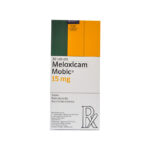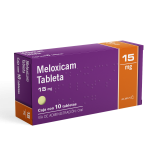The 5 Worst Side Effects Of Meloxicam? (+Warnings)

Meloxicam is a nonsteroidal anti-inflammatory drug (NSAID) that is used to relieve pain and reduce inflammation in conditions such as osteoarthritis, rheumatoid arthritis, and other musculoskeletal disorders. Meloxicam was developed by Boehringer Ingelheim in the early 1990s. It was first approved by the U.S. Food and Drug Administration (FDA) in 2000 for the treatment of osteoarthritis and rheumatoid arthritis.
Meloxicam belongs to the class of NSAIDs that are commonly used to treat inflammation, pain, and fever. It is a selective inhibitor of cyclooxygenase-2 (COX-2), an enzyme that plays a crucial role in the production of prostaglandins, which are responsible for inflammation, pain, and fever.
The development of meloxicam was driven by the need for a safer alternative to traditional NSAIDs, which have been associated with an increased risk of gastrointestinal ulcers and bleeding. Meloxicam was designed to be more selective for COX-2, which is responsible for inflammation while sparing COX-1, which is important for the maintenance of the stomach lining.
Meloxicam has since become one of the most widely prescribed NSAIDs worldwide, with millions of prescriptions written each year. It is available in both oral and injectable formulations and is used to treat a variety of conditions, including arthritis, menstrual cramps, and acute pain.
How meloxicam is meloxicam taken?
Meloxicam is typically taken orally, in the form of tablets or capsules, with a full glass of water. It can be taken with or without food, but it is usually recommended to take it with food or a meal to reduce the risk of stomach upset. The dosage and frequency of meloxicam depend on the condition being treated and the patient’s individual response to the medication.
The recommended starting dose for adults with osteoarthritis or rheumatoid arthritis is typically 7.5 mg once daily. The maximum daily dose is 15 mg.
For the treatment of juvenile rheumatoid arthritis, the recommended starting dose is based on the child’s weight. The usual dose is 0.125 mg per kg of body weight per day, up to a maximum dose of 7.5 mg per day.
For the management of pain, the starting dose is typically 7.5 mg once daily. The maximum daily dose is 15 mg.
It’s important to follow the dosage instructions provided by the doctor or pharmacist. Taking more than the recommended dose can increase the risk of side effects. It’s also important not to take meloxicam for longer than recommended, as long-term use can increase the risk of side effects.
How long can you take meloxicam 15 mg?
The duration of treatment with meloxicam 15 mg depends on the condition being treated and the individual patient’s response to the medication. In general, meloxicam is prescribed for short-term use, typically no longer than 7 days. However, in some cases, it may be prescribed for longer periods of time, up to several weeks or months, under close medical supervision.
It is important to follow your doctor’s instructions regarding the duration of treatment with meloxicam and to never exceed the recommended dosage or take the medication for longer than prescribed. Prolonged use of meloxicam can increase the risk of side effects, including gastrointestinal bleeding and kidney damage. Your doctor may periodically monitor your kidney function and blood pressure while you are taking meloxicam to ensure that the medication is not causing any harm.
Why can’t you lay down after taking meloxicam?
To avoid any potential irritation or ulceration of the stomach or esophagus it is generally recommended to take meloxicam with a full glass of water and remain in an upright position (sitting or standing) for at least 10 to 15 minutes afterward
Meloxicam belongs to a class of drugs known as nonsteroidal anti-inflammatory drugs (NSAIDs), which can increase the risk of stomach bleeding and ulcers, especially when taken for a long period or at high doses. Therefore, it is essential to follow the dosage instructions and precautions provided by your healthcare provider and to avoid lying down immediately after taking meloxicam to reduce the risk of stomach irritation or ulceration.
What are the worst side effects of meloxicam?
Some of the worst side effects of meloxicam are:
1. Increased risk of heart attack and stroke: Meloxicam, like other nonsteroidal anti-inflammatory drugs (NSAIDs), carries a risk of serious cardiovascular events such as heart attack and stroke. The risk of such events may be increased with higher doses or prolonged use of meloxicam, particularly in patients with a history of cardiovascular disease, hypertension, or other risk factors.
Studies have shown that the risk of heart attack or stroke can occur early in treatment and may increase with the duration of use. This risk is especially high in patients who have pre-existing cardiovascular disease or who have recently had a heart attack or stroke. The risk is also higher in patients who take meloxicam at higher doses or for a longer period of time.
Other factors that may increase the risk of heart attack and stroke with meloxicam use include smoking, obesity, high cholesterol, and diabetes. Patients with these conditions should use meloxicam with caution and under close medical supervision.
Patients who experience symptoms of a heart attack or stroke, such as chest pain, shortness of breath, weakness, or slurred speech, should seek immediate medical attention.
2. Gastrointestinal bleeding: One of the potential serious side effects of meloxicam is gastrointestinal bleeding, which can range from mild to life-threatening. Meloxicam can cause irritation and ulcers in the stomach and intestines, leading to bleeding. This risk is particularly high in older adults, those with a history of gastrointestinal bleeding, and those taking other medications that can increase the risk of bleeding, such as aspirin, other NSAIDs, and blood thinners. Signs of gastrointestinal bleeding include black or bloody stools, abdominal pain or cramping, and vomiting blood or material that looks like coffee grounds. If any of these symptoms occur, medical attention should be sought immediately.
To reduce the risk of gastrointestinal bleeding while taking meloxicam, it is recommended to take the lowest effective dose for the shortest possible duration. It is also important to avoid taking other medications that can increase the risk of bleeding and to avoid alcohol consumption. In some cases, doctors may prescribe a medication to protect the stomach lining, such as a proton pump inhibitor, along with meloxicam.
3. Kidney damage: Meloxicam, like other nonsteroidal anti-inflammatory drugs (NSAIDs), can cause kidney damage in some cases. This risk is particularly high in people who have pre-existing kidney disease or those who take meloxicam for long periods or at high doses.
Meloxicam works by blocking the action of an enzyme called cyclooxygenase (COX), which plays a role in producing chemicals that cause pain and inflammation in the body. However, COX also has a protective role in the kidneys, helping to maintain blood flow and oxygen delivery to these organs.
When meloxicam blocks COX, it can interfere with the kidney’s ability to regulate blood flow and filtration, leading to reduced kidney function or even kidney failure in severe cases. Symptoms of kidney damage may include swelling in the ankles or feet, decreased urine output, and difficulty concentrating.
To minimize the risk of kidney damage, it is important to use meloxicam only as directed by a healthcare provider and to take it at the lowest effective dose for the shortest possible duration. People with kidney disease or a history of kidney problems should use meloxicam with caution and be closely monitored by their doctor while taking the medication.
4. Liver damage: There have been rare cases of liver damage associated with the use of meloxicam. Symptoms of liver damage may include yellowing of the skin or eyes, abdominal pain, nausea, and fatigue. Patients who have pre-existing liver disease or who consume alcohol regularly may be at a higher risk of developing liver damage while taking meloxicam. It is important to report any symptoms of liver damage to a healthcare provider immediately. Liver function tests may be recommended periodically for patients who take meloxicam for an extended period.
5. Allergic reactions: Some people may experience an allergic reaction to meloxicam, which can be life-threatening. Symptoms of an allergic reaction can include hives, itching, swelling of the face or throat, difficulty breathing, and wheezing. If you experience any of these symptoms after taking meloxicam, seek medical attention immediately. It’s important to note that if you have a history of allergic reactions to aspirin or other nonsteroidal anti-inflammatory drugs (NSAIDs), you may be at a higher risk of having an allergic reaction to meloxicam.
It is important to note that not everyone who takes meloxicam will experience these side effects, and the risk can be minimized by using the lowest effective dose for the shortest possible duration. Patients should always consult with their healthcare provider before starting or stopping any medication





